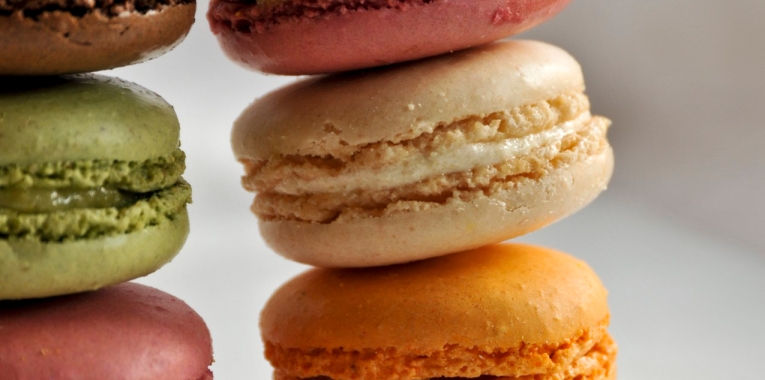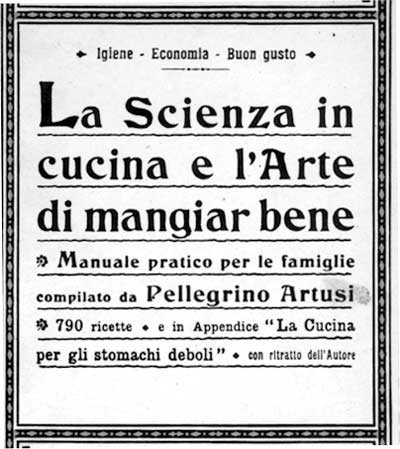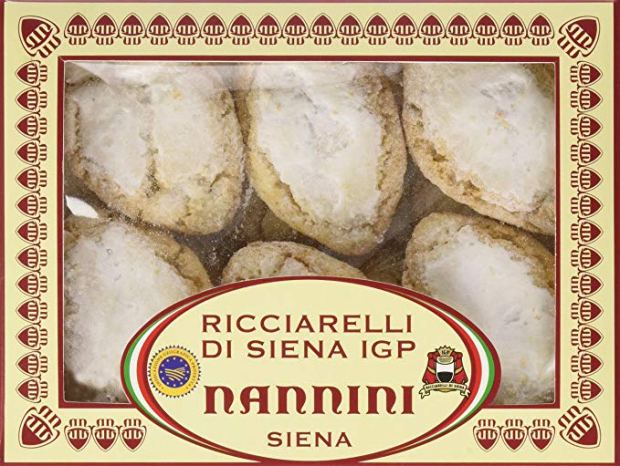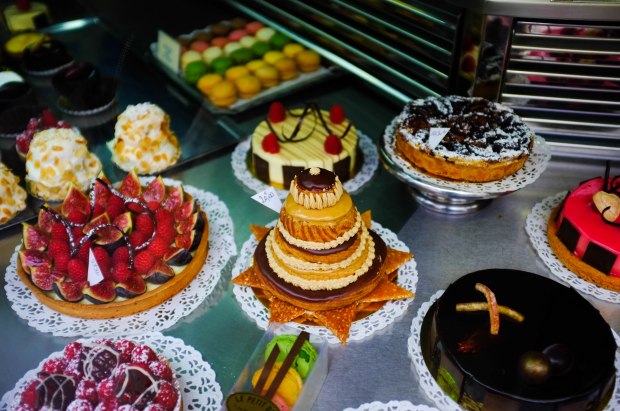
Macarons. The decadent cookies, made of almonds, sugar and egg whites(colored and flavored infinitely, thin, crisp outer crusts as faint as eggshells and chewy interiors, two cookies of which are sandwiched around a buttery, fruity or creamy interior, luxuriously priced, but not out of reach for the splurge of the average consumer), have absolutely exploded in popularity over the past decade. It has become an Instagram-worthy accomplishment for any home baker or Francophile. They are delicate, difficult to make, difficult to ship, difficult to find(even now).
They have become so popular that over the last December holiday I noticed colourful tiered displays of macarons in cafes and bars in Rome, first only an eyeshot from the Pantheon, but then I saw them everywhere. The thing that came first to mind was, ‘Macarons are French! What the hell are they doing in cafes in Rome?’
Well, that thought would be right and wrong.
The French have certainly done their jobs at making the macaron their own over the last hundreds of years, into the colourfully, coveted and famous sweet we all know today. Famously shown in the 2006 movie about the French Queen, ‘Marie Antoinette,’ by Sophia Coppola. The colour palette of which the movie’s fashions and set colours were modelled after were also that of the macarons made by LaDuree, now globally infamous for their example of the modern Parisian macaron.
The tradition of the Macaron is royal indeed. Catherine de’ Medici of Florence, Italy, in 1533 brought her pastry chef with her when marrying Duke of Orleans, Henry II of France. Her pastry chef brought with him the recipe for what we now call the macaron and what was then called maccarone(fine paste). It is said, though I can’t find any definitive documentation on it, that in the 8th century, Venetian Monks made macarons and their popularity spread to the royals, which explains how Catherine’s pastry chef came to have the recipe. I had some doubts that her chefs were Italian, so I did some digging. Her mother was French and her Father, Italian. She was born in Italy and she left to marry Henry when she was only fourteen years old. I thought it possible that in having a French mother her chefs might have been French, but there is one piece of evidence that steers me otherwise. Michel de Montaigne, a French philosopher, was an important character in Catherine’s court during her reign. He has been quoted in praising the cuisine of her Italian cooks. It is by the popular belief that we take that praise at face value, but it is historically stated that he was sarcastic and joking in that praise. It implies that the cooks were not so elegant in their presentation, but it is mentioned that her cooks were indeed Italian and not French. This reinforces the original story that the macaron was Italian. As for almonds being made into sweets, even longer ago still it is said that something closer to marzipan was brought to Italy by Arabs In the 7th century.
In the next phase of macaron history, we find, Catherine de Vaudémont, the granddaughter of Catherine de’ Medici. She founded an Abbey in 1624 in the heart of Nancy, France. It would later become the Monastery of Our Lady of Consolation, in 1631. Her niece, Marguerite de Lorraine, founded in 1668, the convent of the Ladies of the Blessed Sacrament in the same abbey. They made a large variety of pastries, including the macaron. The Sisters of the abbey were forbidden from eating meat so the consumption of nuts was encouraged because “almonds are good for girls that don’t eat meat.(which happens to be true)” During the revolution in 1792, a decree suppressed religious congregations, so it meant that all of the sisters of the abbey were sent out. Marguerite Gaillot(Sister Suzanne) and Marie Morlot(Sister Marie-Elisabeth) took refuge with Dr Gormand, a community doctor, and his family. To thank the family and do their part in the household, the two Sisters made macarons and brought them to market to sell to pay for room and board. The popularity of the macaron spread and the Sisters quickly became locally famous and were nicknamed “Les Soeurs Macarons(The Macaron Sisters),”. In Nancy, they’ve continued to make their macarons as passed down from the Macaron Sisters, generation to generation. Their macaron resembles, what I know to be, a modern day Italian Amaretti or Ricciarelli(a softer version with orange zest). They have the same ingredients, Egg whites, sugar and almonds and a very similar look. Since the process of the Nancy macarons remains a secret I can’t definitively say they are the same, but at least they are strikingly similar. But, even today in France, Italian Amaretti cookies are referred to as “macarons aux amandes.”

Here is where I find a bit of historical confusion. According to the ‘Larousse Gastronomique’:
“Macaroons have been made in the monastery(in Cormery, France) there since 791 and legend has it that they used to be made in the shape of monks’ navels.”
According to the village of Cormery, the first mention of a monastery is when it was founded in 791. Also, within the city’s history, they admit that the sweet originated in Italy in the middle ages(being a broad statement, as the Middle Ages lasted from the 5th to 15th centuries) and found popularity in France, though they don’t explain how the pastry arrived. But, according to the website of ‘Aux Veritables Macarons de L’Abbaye’, a bakery in Cormery still producing their famous macaron today, describe having made the pastry since 1791. A typographical error of a thousand years is a bit of a nail-biter. It is a strikingly similar date to that of 1792, the year the Macaron Sisters hit the scene in Nancy, France. And Cormery is 356 miles(573 km) from Nancy. So, were the Cormery Brothers trying to steal the thunderous fame of the Macaron Sisters or was it the other way around? We will never know for sure. But a sure fire way to compete and make yourself look like the “original” is to claim to have opened on a date just one year before that of your competitor and make your product “unique.” Of course, this is just speculation, but sometimes the truth is stranger than fiction and the coincidences laid out make for a confusing origination story, so one is only led to speculate. In any case, the Cormery Macaron is unique. It doesn’t look like the macaron of Nancy or LaDuree, in fact, it represents more of a doughnut shape(or navel) and were said to be sent out with sailors as they stayed preserved for weeks at a time.
As for the “macaroons” being made in “the shape of monks’ navels,” there are a few renditions of the legend that goes behind it, but this one speaks to me. The Brothers are praying for an answer to make their macarons more unique so that everyone who sees them will know that they are from Cormery:
Séraphin thus immersed himself in his pious prayers. During this time, Brother John, as was custom, toiled away at his ovens when, suddenly, a spark flew out from one of the fireplaces and burnt the Benedictine’s robe, leaving right in the middle, on the front, “a hole edged with black, as round as a ring, not very big it’s true but… you could see the skin!”. Finally, at the first stroke of six, Father Séraphin rushed to the workshop where the macaroons were being cooked. As soon as he arrived he looked through the hole of the lock (because Brother John always kept his door well locked through fear that someone would come to steal his precious secret). “Unfortunately, Brother John, on hearing a noise, turned around showing the astounded father his portly monk’s navel.”
” That God, in his intentions, is therefore impenetrable! “, sighed Séraphin.
And since this memorable night, wise gourmets who want to taste authentic macaroons demand those that bear a nice hole in their centre.
It stands to reason that the macaron could have arrived in Cormery by other means than by the granddaughter of Catherine de Medici. The macaron may possibly have gained so much popularity by that time that it was a commonly known recipe. What we do know about Monasteries and Abbeys is that the Brothers and Sisters, even today, are widely known to bake, make liqueurs, beer and chocolates and sell their goods to support themselves, so these stories do make a lot of sense. But, written recipes of those early, Middle Aged days do not exist to us now so it will remain a mystery how this monastery came by the macaron.
Whilst on the subject, the oldest known written recipe, being closest to what we now know as the macaron, comes from a book called, ‘A Daily Exercise for Ladies and Gentlewomen,’ by John Murrell, published in London, in 1617. The Recipe in question is called: “To Make French Macaroones.” The popularity of the “macaroone” had already spread as far as London. The memory of anything Italian about the cookie had already faded.
Coming again back to Paris, where the macaron now reigns supreme, to the slightly more modern history of “Macaron Parisiennes.” It begins with Pierres Desfontaines, the grandson of Ernest Ladurée, the founder Laduree on Rue Royale in Paris. He claimed to be the modern father of the macaron in the 20th century. What he did do, in 1930, was bring two macarons together with a chocolate ganache filling. He can also be credited for opening a tea room, at the advice of his wife, above his bakery, a place where ladies could eat macarons in privacy and luxury. At that time ladies were not allowed to enter cafes, as that was a man’s domain. Of course, the tea room became extremely popular and the trend caught on.
Claude Gerbet of Chartres had his own bakery during the same time period in Paris. Although his macarons were not mentioned to be sandwiched specifically, he had been responsible for the process in making the “Macaron Gerbet(Parisiennes),” famous for his process of grinding the almond flour with the sugar to make a more refined, delicate cookie in all different flavours, filled or not. The influence he had on Desfontaines is unknown, as is the influence Desfontaines had on Gerbert is equally unapparent. What is known is that sometimes a Macaron in France is referred to as a “Gerbet.”
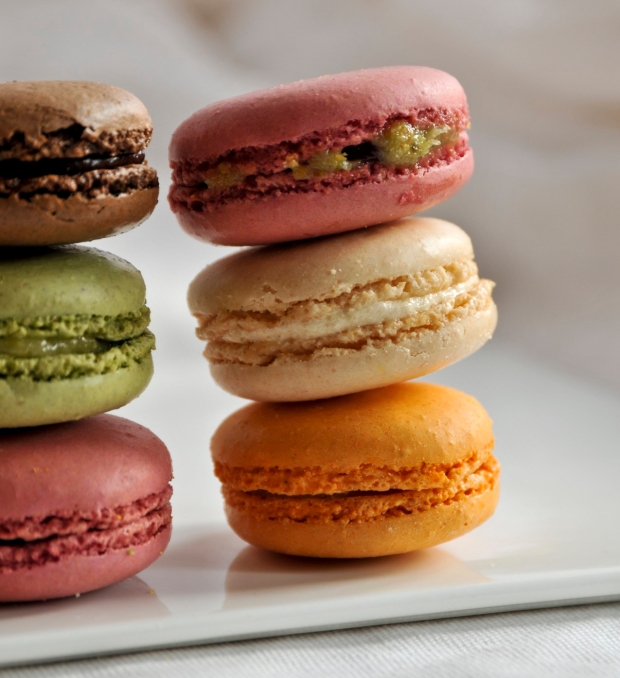
Fast forward to 1993 and Ladurée was brought to the Champs Elysees and then to other locations, increasing its exposure. In 2006, Ladurée opened in London and now it’s luxury branding of the macaron can be found in big cities all over the world. Still, if you find yourself in a small town, getting your hands on these delicate, egg-shell like, chewy cookies will be quite difficult and pricey. They’re best when fresh and crack very easily during shipping.
The Jewish community has long since adopted the macaron. It originally contained only almonds but eventually went on to contain coconut. Coconut went on to even sometimes replace the almonds. Coconut likely became popular around the turn of the century because of its sudden availability. Before that, coconut simply wasn’t available to Europeans before the late 1800’s. They both had their value in not spoiling, but later when beginning to export to the United States they found that shredded and dried coconut was lighter and even less likely to spoil than its nut counterpart and the cookies themselves held up better. It wasn’t for their keeping abilities that the Jewish community fell in love with the Macaron, it was for their allowance in religious holidays, namely, Passover or Pesach, where leavening agents aren’t allowed.
The ban on leavening during Passover is meant to represent the legend that the Jews did not have time to wait for their bread to leaven while fleeing Egypt. In 1919, ‘The International Jewish Cook Book,’ by Florence Kreisler Greenbaum, there is a recipe for ‘Almond Macaroons,’ that looks very similar to that of the recipe for ‘Ricciarelli di Siena(Sienese Almond Cookies),’ in the book, ‘Science in the Kitchen and the Art of Eating Well,’ by Pellegrino Artusi, published in Italy in 1890. The only major difference between the two recipes is the type of citrus zest added. In the Italian version they use orange zest and in the Jewish version they use lemon.
Macarons(oons) have become a traditional part of the Seder meal all over the world. In the United States, you can purchase tins of Manischewitz Macaroons, almond and coconut varieties and a whole slew of other flavours.
It seems that all manifestations of the macaron(macaroon) have found their way around. The recipes are simple and sweet in any of their forms. Thanks to the Italian royals for bringing it to the French court all those years ago. I think only the French were capable of a makeover at quite the level that is has achieved, although difficult to obtain unless you’re lucky enough to have a patisserie specialised in making macarons in your neighbourhood or happen to live in a quite big city. And to the Jewish-Americans who have held so dear to the tradition of the macaroon that it still exists today in such a strong way.
It is a wonder to see how food can travel through time and how a simple Amaretti or Ricciarelli can remain the same for hundreds of years, but to also see the transformations of time act on that simple Amaretti and become the dainty, delicate treat we now know to be the Macaron Parisiennes by the hand of a man with a knife full of ganache.
Here are three recipes associated with the article. Ricciarelli di Siena, one of the original and time-withstanding recipes for “macarons.” Amaretti di Saronno is the most basic and recognisable of the Italian macaron-type cookies also the ones that the Nancy Macarons most resemble. Then there is Les Macarons de Cormery, the most unique French rendering of the older variety of macaron, resembling the monks’ navels. The third is of the oldest published recipe for French Macaroones. (None have been edited, they are all transcribed as written.)
- RICCIARELLI DI SIENA
(SIENESE ALMOND COOKIES)
From the cookbook,
‘La scienza in cucina e l’arte di mangiar bene’
(Science in the Kitchen and the Art of Eating Well),’ 1890
By, Pellegrino Artusi
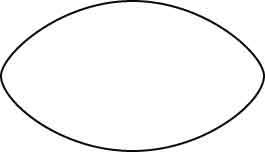
220 grams (about 7-3/4 ounces) of fine white sugar
200 grams (about 7 ounces) of sweet almonds
20 grams (about 2/3 of an ounce) of bitter almonds
2 egg whites
orange zest
Blanch the almonds, dry them in the sun or on the fire, and crush very fine in a mortar with two tablespoons of the sugar, added a little at a time. Then add the rest of the sugar and mix thoroughly.
Beat the egg whites in any type of bowl and pour in the crushed almonds and the orange rind, grated. Mix again with a wooden spoon and pour the mixture onto a pastry board over a thin layer of flour, just enough so that only the very little bit of flour necessary to roll out a soft, flat sheet of dough half a finger thick sticks to it. Then cut out the cookies in the shape indicated blow and you’ll get between 16 and 19 cookies. Bake in the following manner:
Take a baking pan, make a layer of bran as thick as a coin, and cover it entirely with wafers on which you will place the ricciarelli. Bake in the oven at moderate heat so that they stay tender. If you don’t have an oven, which is the best way to bake them use a Dutch oven.
When they’re done, cut off the excess wafer around the edges of each cookie, which will turn out of quite high quality.
Amaretti Classic
Chiostro di Saronno
Ingredients
- bitter almonds not peeled 100 gr
- not blanched almonds: 150 g
- Sugar: 750 gr
- Egg white: 3
- ammonium bicarbonate: 0.5 g
Recipe and preparation
Follow the instructions.
- Mix sugar with ammonium bicarbonate, then put half in a mixer and add all the almonds, chop these ingredients for a few minutes and then add the remaining sugar, and continue to grind until a fine powder.
- Put chopped almonds and sugar in a bowl and then add the egg whites lightly beaten with a fork, mix everything well and then form into balls, coat them in granulated sugar and gradually place them on a baking sheet covered with parchment paper. Bake the amaretti in a preheated oven at 170 °C for 15 minutes.
- Let cool and then serve the amaretti.
Les Macarons de Cormery
(The Macarons of Cormery)
By, Pascal Debaud
As published by ‘Terroir of Tourraine’
Ingredients (for about fifteen macaroons):
– 200 g ground almonds
– 100 g caster sugar
– 50 g icing sugar
– 2 egg whites
– 2 teaspoons bitter orange marmalade
– a few drops of bitter almond extract
Recipe:
- Mix almonds, sugar and icing sugar. Add 3/4 egg whites, bitter almond extract and orange marmalade. Let stand for 2 hours.
- Relax the dough with the rest of the egg whites.
- Make the macaroons.
Form straight rolls of dough using a fluted piping bag or a biscuit pusher. Form circles with these rolls of dough, leaving a hole in the center. Put them on a baking sheet lined with parchment paper.
- Bake in a very hot oven for 5 min (that of Cormery pastry chefs reaches 300 ° C)
- Cool on a wire rack.
Tip: Keep several days in an airtight box
To make French Macaroones 54
‘A Daily EXERCISE for LADIES and GENTLEWOMEN’
By JOHN MYRREL, Professor therof
London, 1617
“With a pound of the newest and the best Jordane Almonds in three or four waters, to take away the renesse from their out-side, lay them in a Bason of warme water all night, the next day blanch then, and dry them in a stone morter, until they be reasonably fine, put to them halfe a pound of fine beaten sugar, and so beat it to a perfect paste, then put in half a dozen spoonefulys of good Damaske Rose-water, three graines of Amber-greece, when you have beaten all this together, dry it on a chafingdish of coales until it grow white and stiffe, then take it off the fire, and put the whites of two new laid Egs first beaten into froath, and so stirre it well together, then lay them on wafers in fashion of little long rowles, and so bake them in an Oven as hot as for Manchet, but you must first let the heat of the Oven passe over before you put them in, when they rise white and light, take them out of the Oven, and put them in a warme platter, and let them again into the warm Oven & so let them remain four or five houres, and then they wil be throughly dry, but if you like them better being, moist, then dry them not after the first baking.”
If you are looking to purchase the various incarnations of the famed cookies from this article:
Ricciarelli di Siena
http://www.fabbricadelpanforte.com/
Amaretti di Saronno
https://www.chiostrodisaronno.it/en/3-crunchy-amaretti
Le Macarons des Soers
http://www.macaron-de-nancy.com/
Aux Veritables Macarons de L’Abbaye (Cormery)
http://www.auxveritablesmacarons.com/
Macarons Parisiens
https://www.laduree.fr/macarons/
Modern Macarons Parisiens
Manischewitz Coconut Macaroons
http://manischewitz.com/product/coconut-macaroons/
Sources:
http://wemagazine.it/golosita-macaron-laduree/
https://www.yummy.co.ke/mystery-macaron/
http://lcweb2.loc.gov/service/rbc/rbc0001/2013/2013pennell59509/2013pennell59509.pdf
http://languageoffood.blogspot.nl/2011/04/macaroons-macarons-and-macaroni.html
http://www.macaron-de-nancy.com/fr/blog/post/historique/
https://www.macaronsandmore.com/blog/almond-odyssey-the-origin-of-french-macarons
http://www.madmacnyc.com/history-of-macarons
https://www.lespetitsmacarons.com/what-is-a-macaron/
http://www.stanislasurbietorbi.com/stanislas/stanislas-hier-aujourd-hui.htm
http://cormery.fr/index.php?page=article&id_categorieA=2&id_article=7
http://cormery.fr/index.php?page=article&id_categorieA=2&id_article=9
http://www.auxveritablesmacarons.com/7-nos-macarons
https://www.youtube.com/watch?v=VXbWaIGMYm0
https://www.youtube.com/watch?v=44fo-cQz9h8
https://www.monproduitdefrance.com/80-pascal-debaud-aux-vrais-macarons-de-cormery
https://www.myjewishlearning.com/the-nosher/why-do-we-eat-coconut-macaroons-on-passover/
